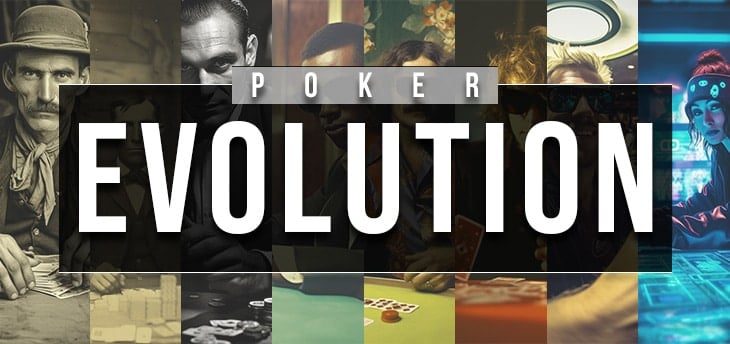Ever sat down at a poker table and wondered, “How did we get here?” No, I’m not talking about that existential crisis you had after losing a big hand. I’m talking about the intricate dance of strategy that unfolds every time the cards are dealt. From it’s humble beginnings, poker has transformed into a global phenomenon, with strategies as complex as a well-aged wine. But how did we get here? Let’s shuffle through the deck of time and find out!
Late 19th – Early 20th Century
Let’s wind the clock back a few decades. Back to a time with smoky saloons, cowboys wearing wide-brimmed hats, and a worn deck of cards. Back in the day, poker was all about the bluff. The strategy? Simple. Make your opponent think you have a better hand than you actually did. But was it really that simple?
Well, yes and no. While the basic premise was straightforward, but mastering the art of deception was no small feat. It wasn’t just about keeping a straight face; it was about reading your opponent, understanding their tells, and making your move at the right moment. And let’s not forget the occasional under-the-table dealings. Ah, the good ol’ days!
Early to Mid 20th Century
As the game matured, players realized that recklessness was the fast track to an empty wallet. Enter the era of tight-aggressive play. Fewer hands, more aggression, and a whole lot of pots won with sheer strategic brilliance.

The Introduction of Math
Fast forward to the 20th century, and the game was changing. Enter the math whizzes. Suddenly, poker wasn’t just about bluffing; it was about calculating odds, understanding probabilities, and making decisions based on cold, hard numbers. Sound boring? Think again!
Imagine trying to calculate the odds of hitting your open-ended straight draw while also trying to read your opponent’s face. Not so easy, right? This new approach added a layer of complexity to the game that made it even more engaging. Players began to realize that while intuition and reading people were important, understanding the math behind the game could give them a significant edge.
The Rise of the Poker Theorists
As poker continued to evolve, a new breed of player emerged: the poker theorist. These were players who didn’t just play the game; they studied it, dissected it, and wrote about it. Books began to appear, offering insights into strategy, game theory, and the psychology of poker.
Doyle Brunson’s “Super/System” – A game-changer that delved deep into the strategies of various poker games.
David Sklansky’s “The Theory of Poker” – A deep dive into the mathematical and theoretical aspects of the game.
These books and many others transformed poker from being viewed as a game of chance to a game of skill. Players now had a wealth of knowledge at their fingertips, and the game became more competitive than ever.
Sklansky’s Brainchild
David Sklansky dropped a bombshell with the concept of the “Gap”. Suddenly, players were rethinking their calls and raises. It was a time of introspection, strategy refinement, and many “Aha!” moments.
The Semi-Bluff
Why just bluff when you can semi-bluff? The 80s introduced this nifty strategy, where players could bet on potential rather than just the present. It was like having your cake and eating it too!
The C-Bet Revolution
The continuation bet, or c-bet, stormed onto the scene and changed the post-flop game forever. It wasn’t just about the cards anymore; it was about the narrative. And boy, did players spin some compelling tales!
The Digital Age
With the advent of the internet, poker went digital. And with online poker came a slew of new tools and software designed to help players analyze their game, track their stats, and improve their strategy. But wait, there’s more! Remember those math whizzes we talked about earlier? They were back with a vengeance, creating algorithms and software to crunch the numbers and give players an edge.
But it wasn’t all about the numbers. Online poker also introduced a new dynamic to the game: the absence of physical tells. Without being able to see your opponent, how do you know if they’re bluffing? This added a new layer of complexity to the game, forcing players to adapt and evolve their strategies once again.
Multi-Tabling
With the dawn of online poker, players weren’t confined to just one table. The more, the merrier became the motto, as multi-tabling took the online poker world by storm. More tables, more hands, more wins!
Playing the Field
Daniel Negreanu popularized the art of playing a wider range of hands with smaller bets. It was all about controlling the pot and keeping opponents guessing. A masterful dance of strategy and intuition!
3 and 4-Betting Light
The poker tables turned aggressive, and players had to adapt. The response? 3-betting and 4-betting light. A bold strategy to tackle aggression head-on and reclaim control of the game.
Floating
Floating became the go-to strategy to counter frequent c-bettors. It was a game of patience, waiting for the perfect moment to seize the pot. A delicate balance of risk and reward!

Blending Old and New
So, where does that leave us today? In a fascinating place, to be honest. Modern poker is a blend of the old and the new. While the mathematical and analytical aspects of the game are more important than ever, the human element remains crucial. Reading your opponent, understanding their strategy, and adapting on the fly are skills that will never go out of style.
And let’s not forget the rise of celebrity poker players. With televised tournaments and high-stakes games, poker has become a spectator sport. Players like Phil Ivey, Daniel Negreanu, and Vanessa Selbst have become household names, known not just for their skill at the table but for their larger-than-life personalities.
So, what’s the secret to their success? A blend of old-school intuition and modern analytical prowess. It’s not enough to be good at math or to have a killer poker face. In today’s game, you need both.
GTO
Game Theory Optimal (GTO) play emerged as the gold standard. Players now aimed for unexploitable strategies, blending old-school intuition with cutting-edge game theory. The quest for poker perfection had truly begun.
Solver-Based Play
With technology at their fingertips, players turned to solvers to refine their strategies. Algorithms, analytics, and a dash of human intuition created a potent mix that redefined modern poker.
The Continuous Evolution of Poker
From the smoky saloons of the Wild West to the high-tech online tables of today, poker has come a long way. Its evolution is a testament to the game’s enduring appeal and its ability to adapt and change with the times.
So, the next time you sit down at a poker table, take a moment to appreciate the rich history and strategy that have shaped the game. And remember, whether you’re bluffing with a pair of twos or calculating the odds of hitting that flush, poker is, and always will be, a game of both chance and skill.

